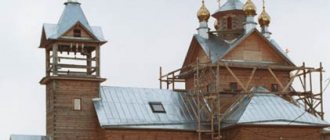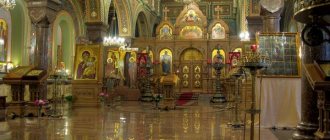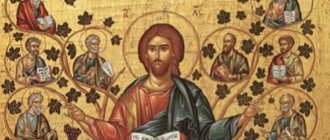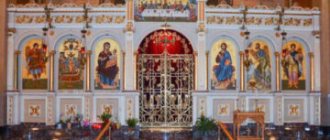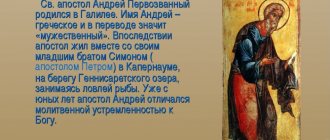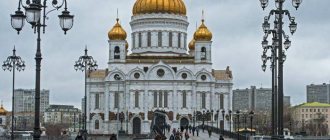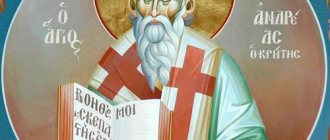Russian Orthodox Church
Christianity spread in Asia Minor thanks to the evangelistic works of the apostles Andrew the First-Called, Paul, Philip, John the Theologian and others.
However, the actual history of the Patriarchate of Constantinople begins in 330, when the city of Constantinople was founded on the site of the ancient village of Byzantium (Byzantion). Since this city became the capital of the Byzantine Empire, the importance of the See of Constantinople constantly increased, and over time it became the first in honor among other Orthodox Churches, although it was inferior in antiquity to some of them.
The see of Constantinople was occupied by such great saints and ecumenical teachers as Saints Gregory the Theologian (+389) and John Chrysostom (+407).
Canonical territory - Turkey (6 dioceses, 10 monasteries and 30 theological schools) and Greece. The jurisdiction of the Patriarchate of Constantinople also extends to a number of dioceses in Western Europe, North and South America, Australia and New Zealand, as well as to Holy Mount Athos; The Finnish Autonomous Orthodox Church also falls under the jurisdiction of Constantinople.
Title of Primate: His Holiness Archbishop of Constantinople - New Rome and Ecumenical Patriarch.
The Patriarchal residence and Cathedral of the Holy Great Martyr George the Victorious is located in Phanar (a district of Istanbul).
Now the Church of Constantinople is headed by the 232nd Patriarch of Constantinople Bartholomew (Archondonis), who was elected Primate on October 22, 1991. The enthronement took place on November 2 of the same year.
Unilateral actions of the Church of Constantinople on the canonical territory of the Russian Orthodox Church in Estonia led in 1996 to a temporary cessation of Eucharistic communion between the two Patriarchates.
In October 2022, as a result of the anti-canonical activities of the Church of Constantinople in Ukraine, the Holy Synod of the Russian Orthodox Church declared it impossible to continue to remain in Eucharistic communion with the Patriarchate of Constantinople (for more details about the actions of the Patriarchate of Constantinople in Ukraine, see below).
***
Dioceses of the Patriarchate of Constantinople (based on materials from the website Pravoslavie.ru)
The Church of Constantinople has a complex and branched structure. Part of it is located on its canonical territory - in Turkey and partly in Greece, but a much larger part is scattered outside this country. There are currently about 3,000 Orthodox Christians left in Turkey, mostly older Greeks.
Bishop's Sees in Turkey
- Archdiocese of Constantinople
- Diocese of Chalcedon
- Diocese of Imvre and Teneda
- Diocese of Prinkiponnis
- Diocese of Derkiya
Bishop's Sees and Patriarchal Institutions outside Turkey
Some Churches outside Turkey that are part of the Patriarchate of Constantinople belong to it traditionally, and not due to the spread of the Greek diaspora throughout the world. These are mainly the Churches on the territory of modern Greece, which only in 1850 received the recognized Autocephalous Church. Before this, all dioceses here were under the jurisdiction of the Patriarch of Constantinople.
The power of the Patriarchate extends to those territories in Greece that became part of this state in later times, in particular after the formation of the Greek Church. Since before entering Greece they belonged jurisdictionally to the Patriarchate of Constantinople, by agreement with both the government of the country and the Greek Church they remained under the ecclesiastical subordination of the Patriarchate. These include the following Churches:
1. Churches of the so-called new territories that became part of the Greek state after the Balkan Wars at the beginning of the 20th century. They, in fact, have double subordination - to the Patriarchate of Constantinople and the Greek Church, which is regulated by relevant agreements dating back to 1928. By now, the subordination of these dioceses to Constantinople is rather formal. In fact, the status of these bishops is almost no different from the status of other dioceses of the Greek Church.
The dioceses of the “new territories” include the following metropolises: Cassandria, Thessaloniki, Drama, Sidirokastria, Lankadas, Poliania, Sisania, Philippi, Neocrine, Naples, Zinchi, Maronia, Alexandroupolis, Paramythia, Yannina, Grevina, Chios, Nicopolis, Ierissos, Serres, Mythimskaya, Elevferupolskaya, Edessa, Kitra, Didimotikhskaya, Mytilene, Limskaya, Gumenisskaya, Veriiskaya, Drininupolskaya, Xanthian, Elassonskaya, Samos, Kastorian, Servian, Florinskaya.
2. Dioceses of the Dodecanese archipelago, which became part of Greece after the Second World War. Among them are the metropolises of the islands: Rodo; Kos; Leros, Kalymnos and Astypalaia; Karpathos and Kasos.
3. Archdiocese of Crete, which has the status of a semi-autonomous Church. The Cretan Church has its own Synod, consisting of all the bishops of the Church.
In addition to the Archdiocese of Crete, located in the capital of the island of Heraklion, the Church also includes seven dioceses: the Metropolis of Gortyna and Arcadia, the Metropolis of Rethymna and Aulopotamus, the Metropolis of Kydonia and Apokorona, the Metropolis of Lamba and Sfakia, the Metropolis of Ierapitna and Sitia, the Metropolis of Petra, the Metropolis of Kisama and Selina. There are several church educational institutions in Crete. The official periodical of the Cretan Church is the magazine “Apostle Titus”.
4. Patmos Exarchy
Included in the direct subordination of the Patriarch. In addition to the island of Patmos, it includes a number of nearby islands: Lipsa, Agathonisos and Arkii. The core of the exarchy is the stauropegial monastery of St. John the Theologian. The exarchy also includes the Cave of the Revelation, in which St. Evangelist John the Theologian ca. In 95 the Revelation was given. There is also a church school on Patmos, founded in 1713 by St. Macarius Kalogeras.
5. Holy Mount Athos
The Athonite monastic “republic” jurisdictionally belongs to the Ecumenical Patriarchate. Despite this, it has virtually complete administrative independence from Constantinople and strictly maintains its internal independence. The patriarchal authority on Mount Athos is represented by the suffragan bishop. Since the Holy Mountain is part of the Hellenic Republic, it has a special representative from the state. The supreme body of self-government of the Holy Mountain is the Holy Kinot, consisting of representatives of all 20 monasteries of Athos, who are elected every year by their monasteries.
Administrative and canonical divisions of the Patriarchate of Constantinople in diaspora
1. American Archdiocese
The largest part of the Patriarchy. The archdiocese was founded on May 11, 1922, although the Greek parishes in America that were included in it appeared in the 60s. XIX century. The American Archdiocese is headed by an archbishop elected by the Synod of the Ecumenical Patriarchate. The Archbishop heads the Synod, consisting of all the bishops of the Church. The Archdiocese consists of the following dioceses: Chicago, San Francisco, Pittsburgh, Boston, Denver, Atlanta, Detroit.
2. Australian Archdiocese
As in the case of other parts of the Patriarchate of Constantinople, the Australian Archdiocese was founded for the purpose of spiritual nourishment of the Greek communities formed on this continent as a result of the resettlement of Orthodox Greeks from Asia Minor and other regions of the former Ottoman Empire. In 1924, the Metropolitanate of Australia and New Zealand was founded for this purpose. In 1959, the metropolitanate was elevated to the status of an archdiocese, which in modern Greek canonical tradition is an upgrade, since an archdiocese can include several metropolitanates.
In 1970, New Zealand was removed from the jurisdiction of the Archdiocese of Australia and received its own archdiocese. The seat of the Australian Archdiocese is Sydney.
3. Archdiocese of Thyatira
Includes Great Britain, the Irish Republic, and Malta. In addition, the Archbishop of Thyatira is the Exarch of Western Europe. Until 1837, the Greek community of London was cared for by the Russian embassy church. She was then allowed to build her temple, which became the beginning of the Greek diocese, which was established as the Metropolis of Thyatira in 1922. In 1954 it received the status of an archdiocese. Then, in 1962, it lost this status, being divided into four metropolitanates. In 1968, it was again returned to the position of archdiocese.
4. Metropolis of France
In addition to France, it includes Spain, Portugal and the Canary Islands. The metropolitanate was founded in 1963, with a see in Paris.
5. Metropolis of Germany
The metropolitanate was founded in 1963, with a see in Bonn. Its jurisdiction extends to Germany. The German Metropolitan is also the Exarch of Central Europe.
6. Metropolis of Austria
It was founded in 1963 and recognized by the state in 1967. Includes parishes in Austria and Hungary. The Metropolitan of Austria is also the Exarch of Central Europe.
7. Metropolitanate of Belgium
Founded in 1969 and recognized by the state in 1985. In addition to Belgium, it also includes Holland and Luxembourg. The department is located in Brussels.
The representation of the Patriarchate of Constantinople to the European Council operates in Brussels.
8. Metropolis of Sweden and all Scandinavia
Founded in 1969, includes Sweden, Norway, Denmark and Iceland.
9. Metropolis of New Zealand
Founded in 1970. Its department is located in Wellington. The New Zealand Metropolis also includes the exarchate of the Patriarchate of Constantinople in South Korea.
10. Metropolis of Switzerland
Founded in 1982, it includes parishes in Switzerland and Liechtenstein. Her department is located in Geneva. The Metropolitan is also the Exarch of Europe. The Metropolitanate of Switzerland plays a key role in the Patriarchate of Constantinople, thanks to the Orthodox Center in Chambesy, a village near Geneva, which also houses the residence of the Metropolitan. This center was founded under Patriarch Athenagoras in case the Patriarch of Constantinople had to leave Istanbul. It also became the center of the ecumenical activities of the Patriarchate of Constantinople, including due to the fact that the World Council of Churches is located in Geneva.
11. Metropolis of Italy
The Greek community in Italy appeared back in 1498, after the fall of the Byzantine Empire. However, the metropolitanate was established only in 1991, and in 1998 it was recognized by the Italian authorities. The department is located in Venice. The Metropolitan is also the Exarch of Southern Europe, occupied by Metropolitan Gennady.
12. Archdiocese of Toronto
Until 1996 it was part of the American Archdiocese, but in 1996 it became a separate metropolitanate, which included all of Canada. The Metropolitan See is located in Toronto.
13. Metropolis of Buenos Aires
Founded in 1996. Previously was part of the American Archdiocese. It includes: Argentina, Brazil, Uruguay, Chile, Paraguay, Colombia, Peru and Ecuador. The Metropolitan is the Exarch of South America. His department is located in Buenos Aires.
14. Metropolis of Panama
Initially it was part of the American Archdiocese, and in 1996 it became a separate diocese. It includes all Central American countries: Panama, Costa Rica, Guatemala, Nicaragua, Andorra, El Salvador, Belize, as well as Venezuela, Mexico, Colombia, the Bahamas, Cuba, Haiti, Puerto Rico, the Dominican Republic and Jamaica. The metropolitan center is located in Mexico City, Mexico.
15. Metropolitan of Hong Kong
Established in 1996. The Metropolitan is also the Exarch of Southeast Asia.
The metropolitanate includes the exarchies of India (with its center in Calcutta), Indonesia, and the Philippines. There are also communities in Singapore and Thailand.
16. Ukrainian parishes of the Patriarchate of Constantinople
Although Ukrainian communities in the Americas and Europe do not have their own dioceses, they do have their own bishops, who are subordinate to the higher church authorities of the Patriarchate of Constantinople. For example, in America and Canada this is the American Archdiocese.
17. Exarchate of parishes of the Russian tradition in Western Europe
These parishes for the most part constituted that part of the Russian Orthodox Church that, together with Metropolitan Eulogius, came under the omophorion of the Patriarch of Constantinople. The Exarchate includes the Orthodox St. Sergius Theological Institute.
***
Anti-canonical actions of the Patriarchate of Constantinople in Ukraine
On September 7, 2022, a communiqué of the General Secretariat of the Holy Synod of the Patriarchate of Constantinople was published, which announced the appointment of two hierarchs of this Church - Archbishop Daniel of Pamphylia (USA) and Bishop Hilarion of Edmonton (Canada) - “exarchs” of the Patriarchate of Constantinople in Kyiv.
This decision was made without the consent of His Holiness Patriarch Kirill of Moscow and All Rus' and His Beatitude Metropolitan Onuphry of Kyiv and All Ukraine.
The reaction to the anti-canonical actions of the Patriarchate of Constantinople was the statements of the Holy Synod of the Russian Orthodox Church on September 8 and 14. The statement dated September 14, in particular, notes: “If the anti-canonical activities of the Patriarchate of Constantinople continue on the territory of the Ukrainian Orthodox Church, we will be forced to completely break off Eucharistic communion with the Patriarchate of Constantinople. Full responsibility for the tragic consequences of this division will fall personally on Patriarch Bartholomew of Constantinople and the bishops who support him.”
Having ignored the calls of the Ukrainian Orthodox Church and the entirety of the Russian Orthodox Church, as well as the fraternal Local Orthodox Churches, their Primates and bishops for a pan-Orthodox discussion of the “Ukrainian question,” the Synod of the Constantinople Church made unilateral decisions: to confirm the intention “to grant autocephaly to the Ukrainian Church”; about the opening in Kyiv of the “stauropegia” of the Patriarch of Constantinople; about the “restoration to the episcopal or priestly rank” of the leaders of the Ukrainian schism and their followers and the “return of their believers to church communion”; on the “cancellation of the effect” of the conciliar charter of the Patriarchate of Constantinople of 1686 concerning the transfer of the Kyiv Metropolis to the Moscow Patriarchate. A message about these decisions was published by the Patriarchate of Constantinople on October 11.
At a meeting of the Holy Synod of the Russian Orthodox Church, held on October 15, a statement was adopted in connection with the encroachment of the Patriarchate of Constantinople on the canonical territory of the Russian Orthodox Church. Members of the Holy Synod recognized it as impossible to continue to remain in Eucharistic communion with the Patriarchate of Constantinople.
The statement, in particular, says: “The acceptance into communion of schismatics and a person anathematized in another Local Church with all the “bishops” and “clergy” ordained by them, an encroachment on other people’s canonical inheritances, an attempt to renounce one’s own historical decisions and obligations - all this takes the Patriarchate of Constantinople beyond the canonical field and, to our great sorrow, makes it impossible for us to continue Eucharistic communion with its hierarchs, clergy and laity.”
“From now on, until the Patriarchate of Constantinople refuses the anti-canonical decisions it has made, it is impossible for all clergy of the Russian Orthodox Church to concelebrate with the clergy of the Church of Constantinople, and for the laity to participate in the sacraments performed in its churches,” the document states.
The Holy Synod of the Russian Orthodox Church also called on the Primates and Holy Synods of Local Orthodox Churches to properly assess the above-mentioned anti-canonical acts of the Patriarchate of Constantinople and to jointly search for ways out of the grave crisis tearing apart the body of the One Holy Catholic and Apostolic Church.
On December 15 in Kiev, on the territory of the National Reserve “Sophia of Kiev”, under the chairmanship of the hierarch of the Patriarchate of Constantinople, Metropolitan Emmanuel of Gallia, a so-called unification council took place, at which it was announced the creation of a new church organization called “The Orthodox Church of Ukraine”, which arose as a result of the unification of two non-canonical structures: “ Ukrainian Autocephalous Orthodox Church" and "Ukrainian Orthodox Church of the Kyiv Patriarchate".
Materials about the anti-canonical actions of the Patriarchate of Constantinople in Ukraine are published on the website “In Defense of the Unity of the Russian Church”
Creation
There is a legend that the founder of the Church of Constantinople was Andrew the First-Called. The disciple Stachys ordained by him in about 38 became the bishop of the city of Byzantion. Here, in the first half of the 3rd century, Constantine the Great founded the new capital of the Roman Empire - Constantinople.
The Second Ecumenical Council of 381 adopted the third rule. It speaks of the second most honorable position of the Archbishop of Constantinople. The only person more important than him is the Pope. In the mid-5th century, at the Council of Chalcedon, the Ecumenical Church received its Patriarch, and the Church of Constantinople became a patriarchate. In the Vatican, for the first time, the bishop of Constantinople was recognized as second in rank by Pope Gregory the Great.
The Armenian Church asserted that Constantinople has the right to its bishops in foreign lands that are not part of its diocese. In 988, Patriarch Nicholas II of Constantinople Chrysoverg sent his representatives to Rus'. From them, Prince Vladimir of Kiev and the Russian people received baptism.
Patriarchate of Constantinople in the 20th century
At the end of the 20s. In the 20th century, by decision of the Turkish government, all Asia Minor Orthodox metropolises were closed. The metropolitans had to settle in Greece or become powerless hierarchs in Constantinople. Patriarch Meletios was the first to say that the entire Orthodox diaspora belongs to the Patriarchate of Constantinople according to the canon. At the same time, he referred to several rules adopted at the Council of Chalcedon.
In 1964, Pope Paul VI and Patriarch Athenagoras met in the city of Jerusalem. A year later, the mutual anathemas were lifted and the Joint Declaration was signed. Today, Constantinople has under its jurisdiction a number of ecclesiastical areas in Crete and Athos, in Chalkidiki and other Greek dioceses. It also includes the Finnish Autonomous Church and many dioceses in different parts of the world.
In 1954, the Patriarchate of Constantinople suffered from a Muslim pogrom. A year later, the entire Greek community was subjected to repression in the city. In the mid-90s. In the 20th century, terrorists attempted and blew up Orthodox churches. In 1971, by decision of the Turkish government, the theological school in Halq was closed, and 27 years later its board of trustees was dissolved.
Schism in Christianity and restoration of communion between Churches
In 1054, a great schism occurred, which led to the cessation of first church-canonical, and later eucharistic communion between Constantinople and the Vatican. Both Churches blamed the other side for the fact that the United Church split. In addition, Constantinople called the Pope a heretic.
In 1274, the Council of Lyon took place, where the Vatican and the Church of Constantinople entered into a union for the first time, which was repeated in the first half of the 15th century during the Ferraro-Florence Council. But the church people rejected both unions, which led to the re-establishment of the Patriarchate of Constantinople. In the mid-15th century, supporters of the union were expelled from their territory by the Ottoman Turks. Only the Patriarchate of Constantinople received recognition from them.
In 1862-1923. The patriarchy was governed by a Mixed Council, which included four bishops and eight laymen elected for a two-year term. At the same time, a multi-stage procedure for the election of the patriarch was introduced, which was based on the “General Statutes” of 1860.
